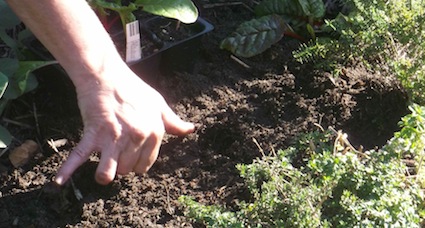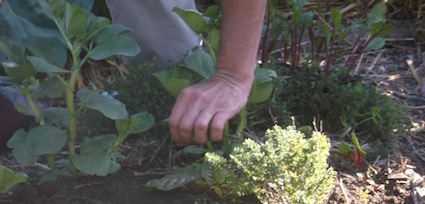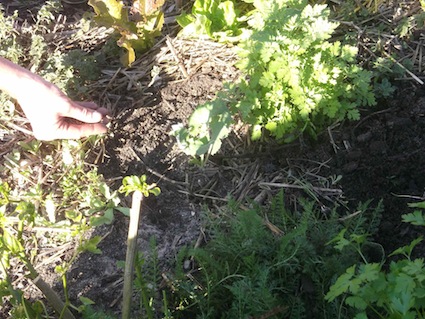Dear Reader, in this age of AI created content, please support with your goodwill someone who works harder to provide the human-made. Sign up at the top of the lefthand column or bottom of this page. You will receive my hand illustrated monthly newsletter RESTORE NATURE and access to the biodiversity garden design course as I write...and nothing else, I respect your time. I am also removing the advertizing as best I can as its become intrusive inappropriate and pays me nothing.
planting vegetable gardens according to permaculture principles

karen spacing the vegetable plantings
Grouping for shade when planning a vegetable garden
Vegetables need sunshine. To insure this when planting vegetable gardens, and planning them, tall evergreens are planted closer to the south fence, which would be the northern fence in the northern hemisphere, of course.
They should be are planted 2.5 meters from the fence in South Africa to insure the neighbors also get some sun. Medium sized trees and then smaller shrubs are planted in front of these tall trees. I didn’t do this, due to lack of knowledge, when I planted my own garden, and it now has two tiny sun spots, because tall buildings and a huge Acacia tree on the north border of the garden block the sun.
On a smaller scale, peas that grow tall are trellised on the south side of a bed, then in a northward direction, broad beans then chard, then thyme are planted, decreasing progressively in height.
successful companion planting in beds in Saskia’s garden
Another consideration when planting vegetable gardens the permaculture way is that every plant must have three uses in a permaculture garden, as a rule of thumb of course. I think here its necessary to be careful of being guided too much by common global permaculture lore, which may have areas of lack of knowledge, like on indigenous South African plants. In part we have no choice, there is very little information, so its up to us to be pioneer gardeners, and learn about indigenous companion planting, in addition to using pioneer plantings !
Planting vegetable gardens, for example carrots

KAREN'S CAPABLE HANDS RAPIDLY CLEAR THE ROW FOR PLANTING
Karen cleared a place between the plants to sow carrots and show us how simple planting vegetable gardens is in permaculture. She didn’t make a big fuss of it and did it in a few minutes. Carrots don’t like chunky organic matter, it makes them branch. All the soil must be old and fine grained. She checked that there was no coarse material in the row, then she watered it thoroughly. Always water first and then sow, so as not to disturb the seeds you have laid down. Cover the seed row afterward with some hessian so that future watering doesn’t splash the seeds out of the soil. Her rule of thumb for seed depth is that the seed should be covered by an equal amount of soil to the greatest length of the seed along its longest axis.
Planting carrots, whose seeds are minute, mix them with radish seed and sand, to thin them. They can be sown throughout the year. Make a small groove, sow, pinch the rill closed, and pat ontop. When they come up, thin the carrots in three stages, take the smaller carrots each time to make space for others.
This article is the third in a series of five based on a permaculture workshop on companion planting I attended in May 2016. The first is on plant guilds the essence of companion planting, the second on antagonism and beneficial plants, with a useful internet source on permaculture principles, this article is of course on planting vegetable gardens (and planning them), the fourth will deal with garden pests and the last with soil and its regeneration.
Saskia walked us around her garden to show us several successful plantings. The combinations were as follows:
In the vegetable patch which is about 16 meters square:
Amarinth, artichoke, potato, onions, marigolds, poppies all grow in one bed with Sutera, that has a small white flower as a good ground cover
The hedges are of blue Felicia, and perennial basil.
In another quadrant grow yarrow and lettuce, dill, chilli, and poppies.
Mustard and chilli growing together
Lemon balm and yarrow and celery
Chamomile and onion
Parsley and celery and yarrow
Carrots and yarrow
Peas and beans can grow together and are not antagonists, as reputed, if there is enough diversity in the garden planting.
In another part of the garden pawpaw and fig do well together. Close by is a tree tomato. It needs a sunny spot, is fast and early to mature, and was planted as a ‘pioneer’ tree.

sewing the carrots in a matrix of friendly companions
------
home page for other green ideas
------
vegetable gardening the natural low cost way
------
gardening and where it all started
------
link to the next companion planting workshop page on pests
------
You’re a home gardener ! Share your experiences and questions !
We all know about home gardening. Tell us about your successes, challenges and ask about issues that bother you. You may have the luxury of a back garden, but there are other ways we learn. Few people age without growing something or buying vegetables during their lives ! It is absolutely guaranteed that you have learned things which can help others on their gardening journey.
We invite you to share your stories, ask questions, because if a thing has bothered you it will bother others too. Someone may have a solution ! No question is too small. There is learning for everyone involved, for you, for me (yes, I learn from every question), for us all. Exciting stuff !
We are starting on a new journey. Every week we will profile your letters ! The best stories and questions we receive.
What Other Visitors Have Said
Click below to see contributions from other visitors to this page...
the most gentle rose for watering vegetable seedlings 




I just want to show you the easiest to make, recycled rose for watering seedlings. I learned this trick from William Isaacs at SEED.
Take an old water …
Restore Nature Newsletter
I've been writing for four years now and I would love to hear from you
Please let me know if you have any questions, comments or stories to share on gardening, permaculture, regenerative agriculture, food forests, natural gardening, do nothing gardening, observations about pests and diseases, foraging, dealing with and using weeds constructively, composting and going offgrid.
SEARCH
Order the Kindle E-book for the SPECIAL PRICE of only
Prices valid till 30.09.2023
Recent Articles
-
garden for life is a blog about saving the earth one garden at a time
Apr 18, 25 01:18 PM
The garden for life blog has short articles on gardening for biodiversity with native plants and regenerating soil for climate amelioration and nutritious food -
Cape Flats Sand Fynbos, Cape Town's most endangered native vegetation!
Apr 18, 25 10:36 AM
Cape Flats Sand Fynbos, a vegetation type found in the super diverse Cape Fynbos region is threatened by Cape Town's urban development and invasive alien plants -
Geography Research Task
Jan 31, 25 11:37 PM
To whom it may concern My name is Tanyaradzwa Madziwa and I am a matric student at Springfield Convent School. As part of our geography syllabus for this
"How to start a profitable worm business on a shoestring budget
Order a printed copy from "Amazon" at the SPECIAL PRICE of only
or a digital version from the "Kindle" store at the SPECIAL PRICE of only
Prices valid till 30.09.2023








